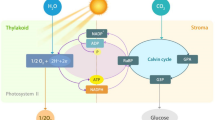Summary
The performance of crassulacean acid metabolism (CAM) by dicotyledonous trees of the genusClusia sampled at three sites in the state of Falcon in northern Venezuela is characterized.Clusia leaves have a somewhat succulent appearance. Unlike leaves of many other CAM plants, which are uniformly built up of very large isodiametric cells, there are distinct layers of palisade and spongy mesophyll, with individual cells being smaller. There is no specialized water storage tissue. δ13C values indicate thatC. multiflora in the elfin-cloud forest on top of Cerro Santa Ana, at ∼800 m altitude, performs C3 photosynthesis (δ13 −27.1‰). However,C. rosea in the tall cloud forest on Cerro Santa Ana (∼600m altitude), andC. rosea andC. alata in the dry forest on Serrania San Luis (∼900 m altitude) perform CAM (δ13C −14.1 to −19.2‰). InC. alta andC. rosea there were large day-night changes in the levels of malic and citric acids ranging from 63 to 240 mmol 1−1 for malid acid and from 35 to 112 mmol 1−1 for citric acid. The sum of the changes in malate and citrate levels accounts for the changes of titratable protons measured. With a day-night change of titratable protons of 768 mmol 1−1 in one of the analyses,C. rosea showed the highest value yet encountered in a CAM plant. Oscillations of free sugars (fructose, glucose, sucrose) and of starch were also analysed in the CAM performingClusia species. Carbon skeletons of the precursors involved in nocturnal malate and citrate synthesis largely derive from free sugars and not from polyglucan. Unlike some other CAM plants, there is no clear and quantitative correlation between day-night changes of organic acid levels and cell sap osmolality.
Similar content being viewed by others

References
Albert R, Popp M (1978) Zur Rolle der löslichen Kohlenhydrate in Halophyten des Neusiedlersee-Gebietes (Österreich). Oecol Plant 13: 27–42
Diaz M (1983) Estudios fisioecologicos de 4 especies de cactaceas en condiciones naturales. Thesis, Instituto Venezolano de Investigaciones Cientificas Caracas
Janauer GA, Kinzel H (1976) Die Wirkung von Atrazin auf den Stoffwechsel vonPhaseolus vulgaris L. II. Kohlenhydrate und organische Säuren. Z Pflanzenphysiol 77: 383–394
Kenyon WH, Severson RF, Black CC (1985) Maintenance carbon cycle in crassulacean acid metabolism plant leaves. Source and compartmentation of carbon for nocturnal malate synthesis. Plant Physiol 77: 183–189
Kluge M, Ting IP (1978) Crassulacean acid metabolism. Analysis of an ecological adaptation. Springer, Berlin Heidelberg New York
Lüttge U (1987) Carbon dioxide and water demand: Crassulacean acid metabolism (CAM), a versatile ecological adaptation exemplifying the need for integration in ecophysiological work. New Phytol 106: 593–629
Lüttge U (1988) Day-night changes of critric-acid levels in crassulacean acid metabolism: phenomenon and ecophysiological significance. Plant Cell Environ in press
Lüttge U, Smith JAC (1984) Mechanism of passive malic-acid efflux from vacuoles of the CAM plantKalanchoë daigremontiana. J Membr Biol 81: 149–158
Medina E, Olivares E, Diaz M (1986) Water stress and light intensity effects on growth and nocturnal acid accumulation in a terrestrial CAM bromeliad (Bromelia humilis Jacq.) under natural conditions. Oecologia 70: 441–446
Möllering H (1974) Malat-Bestimmung mit Malat-Dehydrogenase und Glutamat-Oxalacetat-Transaminase. In: Bergmeyer HO (ed) Methoden der enzymatischen Analyse, vol 2. Verlag Chemie, Weinheim, pp 1636–1639
Möllering H, Gruber W (1966) Determination of citrate with citrate-lyase. Anal Biochem 17: 369–376
O'Leary MH (1981) Carbon isotope fractionation in plants. Phytochemistry 20: 553–567
Osmond CB (1978) Crassulacean acid metabolism: a curiosity in context. Annu Rev Plant Physiol 29: 379–414
Osmond CB, Winter K, Ziegler H (1982) Functional significance of different pathways of CO2 fixation in photosynthesis. In: Lange OL, Nobel PS, Osmond CB, Ziegler H (eds) Encyclopedia of plant physiology, NS vol 12 B. Physiological plant ecology. II. Water relations and carbon assimilation, Springer, Berlin Heidelberg New York, pp 479–547
Phillips RD, Jennings DH (1976) The estimation of plant organic acids by gas-liquid chromatography. New Phytol 77:333–339
Popp M, Kinzel H (1981) Changes in the organic acid content of some cultivated plants induced by mineral ion deficiency. J Exp Bot 32: 1–8
Rössner H, Popp M (1986) Ionic patterns in someCrassulaceae from Austrian habitats. Flora 178: 1–10
Smith JAC, Griffiths H, Lüttge U, Crook CE, Griffiths NM, Stimmel KH (1986) Comparative ecophysiology of CAM and C3 bromeliads. IV. Plant water relations. Plant Cell 9: 395–410
Spurr AR (1969) A low-viscosity epoxy resin embedding medium for electron microscopy. J Ultrastruct Res 26: 31–43
Sternberg L da SL, Ting IP, Price D, Hann J (1987) Photosynthesis in epiphytic and rootedClusia rosea Jacq. Oecologia (Berlin) 72: 457–460
Sweeley CC, Bentley R, Makita M, Wells NW (1963) Gas-liquid chromatography of trimethylsilyl derivatives of sugars and related substances. J Am Chem Soc 83: 2497–2507
Ting IP, Lord EM, Sternberg L da SL, De Niro MJ (1985) Crassulacean acid metabolism in the stranglerClusia rosea Jacq. Science 229: 969–971
Tinoco Ojanguren C, Vazquez-Yanes C (1983) Especies CAM in la selva humeda tropical de Los Tuxtlas, Veracruz. Bol Soc Bot Mex 45: 150–153
Troughton JH (1979) δ13C as an indicator of carboxylation reactions. In: Gibbs M, Latzko E (eds) Enzyclopedia of plant physiology, NS vol 6. Photosynthesis. II. Photosynthetic carbon metabolism and related processes, Springer, Berlin Heidelberg New York, pp 140–149
Vareschi V (1980) Vegetationsökologie der Tropen. Ulmer, Stuttgart
Vickery HB (1952) The behaviour of isocitric acid in excised leaves ofBryophyllum calycinum during culture in alternating light and darkness. Plant Physiol 27: 9–17
Walter H, Breckle SW (1983) Ökologie der Erde, vol 1. Ökologische Grundlagen in globaler Sicht. Fischer, Stuttgart
Walter H, Medina E (1971) Caracterización climática de Venezuela sobre la base de climadiagramas en estaciones particulares. Bol Soc Venez Cienc Nat 29: 211–240
Willis JC (1973) A dictionary of the flowering plants and ferns. Cambridge University Press, Cambridge
Author information
Authors and Affiliations
Additional information
Dedicated to Professor Dr. Otto L. Lange on the occasion of his 60th birthday.
Rights and permissions
About this article
Cite this article
Popp, M., Kramer, D., Lee, H. et al. Crassulacean acid metabolism in tropical dicotyledonous trees of the genusClusia . Trees 1, 238–247 (1987). https://doi.org/10.1007/BF01816822
Received:
Issue Date:
DOI: https://doi.org/10.1007/BF01816822



